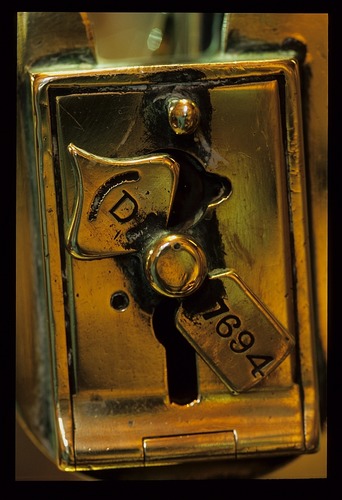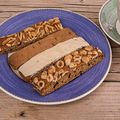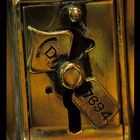Lock of a Spirit Safe
You can think of the spirit safe as the "mission control" of the stillroom, though one whose beautiful brass-bound and padlocked case might be more at home overseeing a space flight organised by Jules Verne than by NASA.
The spirit safe is designed to allow the distiller to analyse and manage the destination of the product of the spirit still as it emerges from the spirit condenser, but without ever coming into contact with the spirit itself. Its origins date back to 1823 when the duty laws were changed to allow small Highland distilleries to compete on equal terms with the large Lowland distilleries. The effect was to bring within the law a lot of distillers who had previously operated illegally.
The price paid for the fairer duty laws was rigorous enforcement of them, and one of the main control mechanisms was the spirit safe. This prevented anyone tapping off (and so avoiding paying duty on) the spirit at is most vulnerable point: as it emerged from the still and before anyone had measured how much of it there was.
This explains why spirit safes carry large and obvious padlocks, and why all the manipulation and measurement takes place behind its glass panels, using controls on the front of the spirit safe. Until 1983 the only keys to the padlocks were held by the local officer from the Customs and Excise, who also measured how much spirit was produced. Since then the keys have been held by the distillery manager, and Customs and Excise ensure compliance by analysing returns from a range distilleries.
The first liquid to emerge from the spirit condenser as the spirit still is heated is the undesirable foreshots, and these are directed from the spirit safe to the low wines and feints receiver for re-distillation. But gradually the alcohol content reduces and what emerges is the spirit that will end up as Scotch Whisky. The distiller has to judge the right moment to redirect the flow of product to the spirit receiver instead of the low wines receiver. This is when the alcohol content, measured by a hydrometer in the spirit safe, falls to 75%: or when the emerging spirit no longer turns water cloudy, another test conducted remotely inside the spirit safe.
The alcohol content of the emerging liquid continues gradually to fall during the run. When it reaches a point between 70% and 60% alcohol by volume, again as measured by a hydrometer within the spirit safe, the flow is switched away from the spirit receiver and back to the low wines and feints receiver, again for re-distillation. The precise point at which this switch takes place depends on the character of the whisky being produced: but for a particular whisky this will always happen at the same point in the run.
text geklaut von den seiten von undiscoveredscotland










Joachim Irelandeddie 22/12/2008 22:21
Sehr schöne Detailaufnahme, tolle Schärfe und ein klasse Motiv!lg irelandeddie
Gregor Luschnat GL-ART-PHOTOGRAPHY 21/12/2008 13:58
schönes Detail.LG
Gregor
Art light photography by p.D. 01/04/2007 3:17
Wieder eine sehr schöne Aufnahme von Dir !Klasse gemacht und eine sehr schöne Arbeit von Dir .
Das Foto gefällt mir.
glg.peter
Gudrun Raatschen 15/11/2006 19:43
Ganz klasse.LG Gudrun
Alfred Janßen 15/11/2006 15:47
Detail sehr schön getroffen - tolles Foto !(Highland Park ?)
Gruß,
Alfred
Antonio Spiller 25/06/2006 16:43
Perfektes Detail, schön.VG AntonioS
Charles Fowler 29/04/2005 2:52
Hi Ralf,Nice old lock. :-)
Cheers,
Chas
Reiner Erdt 18/04/2005 1:41
Im nächsten Leben werde ich Destilleriebesitzer.;o))
Deine Bilder sind immer wieder sehr einladend...